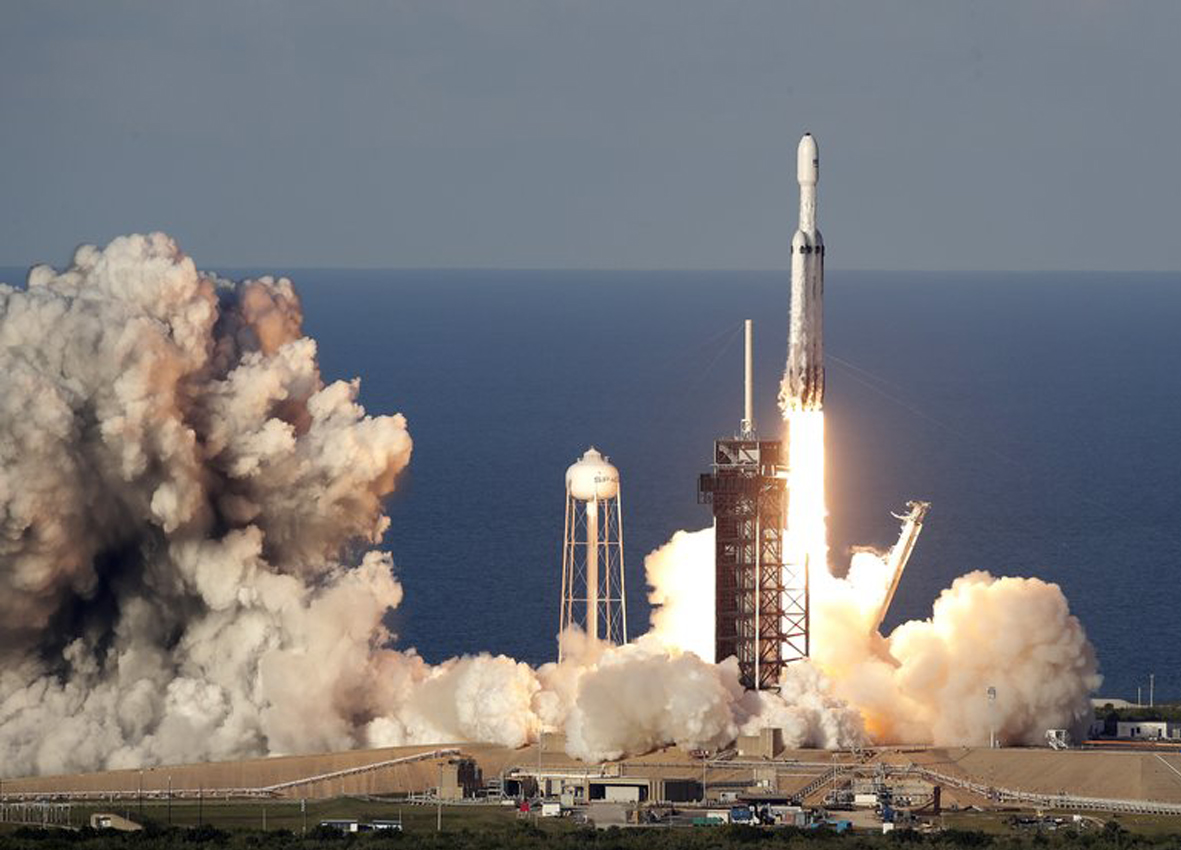
SpaceX launches mega rocket, lands all 3 boosters
CAPE CANAVERAL, Fla. -- SpaceX launched its second supersized rocket and for the first time landed all three boosters Thursday, a year after sending up a sports car on the initial test flight.
The new and improved Falcon Heavy thundered into the early evening sky with a communication satellite called Arabsat, the rocket's first paying customer. The Falcon Heavy is the most powerful rocket in use today, with 27 engines firing at liftoff -- nine per booster.
Eight minutes after liftoff, SpaceX landed two of the first-stage boosters back at Cape Canaveral, side by side, just like it did for the rocket's debut last year. The core booster landed two minutes later on an ocean platform hundreds of miles offshore. That's the only part of the first mission that missed.
"What an amazing day," a SpaceX flight commentator exclaimed. "Three for three boosters today on Falcon Heavy, what an amazing accomplishment."
The Falcon Heavy soared from NASA's Kennedy Space Center, using the same pad that shot Apollo astronauts to the moon a half-century ago and later space shuttle crews.
Nearby beaches and other prime viewing spots were packed with tourists and locals eager to catch not just the launch but the rare and dramatic return of twin boosters, accompanied by sonic booms. The roads were also jammed for Wednesday night's launch attempt, which was scuttled by high wind.
Because this was an upgraded version of the rocket with unproven changes, SpaceX chief Elon Musk cautioned in advance things might go wrong. But everything went exceedingly well and the satellite ended up in the proper orbit. SpaceX employees at company headquarters in Southern California cheered every launch milestone and especially the three touchdowns.
"The Falcons have landed," Musk said in a tweet that included pictures of all three boosters.
NASA offered swift congratulations. "From our iconic launch pads at @NASAKennedy, we will continue to support the growing commercial space economy," NASA tweeted. Musk replied with three red hearts.
Musk put his own Tesla convertible on last year's demo. The red Roadster -- with a mannequin, dubbed Starman, likely still at the wheel -- remains in a solar orbit stretching just past Mars.
The Roadster is thought to be on the other side of the sun from us right now, about three-quarters of the way around its first solar orbit, said Jon Giorgini, a senior analyst at NASA's Jet Propulsion Laboratory in Pasadena, California.
A couple dozen ground telescopes kept tabs on the car during its first several days in space, but it gradually faded from view as it headed out toward the orbit of Mars, Giorgini noted.
The Roadster could still look much the same as it did for the Feb. 6, 2018, launch, just not as shiny with perhaps some chips and flakes from the extreme temperature swings, according to Giorgini. It will take decades if not centuries for solar radiation to cause it to decompose, he said.
SpaceX plans to launch its next Falcon Heavy later this year on a mission for the U.S. Air Force. The boosters for that flight may be recycled from this one.
NASA Administrator Jim Bridenstine last month suggested possibly using a Falcon Heavy -- and another company's big rocket -- to get the space agency's Orion capsule around the moon, minus a crew, in 2020. But the preferred method remains NASA's own Space Launch System mega rocket -- if it can be ready by then.
Bridenstine said everything is on the space table as NASA strives to meet the White House's goal of landing astronauts back on the moon by 2024.
NASA's Saturn V rockets, used for the Apollo moon shots, are the all-time launch leaders so far in size and might.
SpaceX typically launches Falcon 9 rockets. The Falcon Heavy is essentially three of those single rockets strapped together.
Until SpaceX came along, boosters were discarded in the ocean after satellite launches. The company is intent on driving down launch costs by recycling rocket parts.
Source: https://mainichi.jp/english/articles/20190412/p2g/00m/0in/044000c
 English
English Japan
Japan

amoxicillin and beer [url=https://a-mo-xil.com/#]medicine amoxicillin 500 [/url] amoxicillin for dogs amoxicillin for tonsillitis
grapefruit seed extract dosage fresenius lawsuit update 2017 taking viagra after eating buying viagra 100 mg cialis reviews dark blue m 30 pill
neurontin od neurontin prescription does neurontin cause erectile dysfunction what is gabapentin used for
dapoxetine potex [url=http://pri-li-gy.com/#]priligy buy [/url] buy priligy in the usa how long before sex should i take dapoxetine
albuterol price is there a generic albuterol inhaler how long does albuterol stay in your system
pain pill look alikes viagra sans ordonnance tadalafil without a doctor's prescription samples for healthcare professionals tadalafil 2.5 mg best price benefits of pink grapefruit viagra prices best over the counter ed pills gnc male enhancement pills viagra as a party drug cvs coupons for prescriptions viagra pornhub class a drugs list usa pfizer patient assistance application form viagra cost age for birth control pills plavix lawsuit settlement amounts 2016 viagra pill mixing diazepam and alcohol google viagra blue pill effects of viagra for women real viagra without a doctor prescription what is viagra cialis and cocaine viagra age restrictions homemade viagra best supplements for libido men viagra overnight delivery natural viagra for men sildenafil use in dogs benefits of grapefruit
does plaquenil plaquenil 200 mg oral tablet what kind of antibiotic is plaquenil how soon is plaquenil processed by the body
plaquenil skin cancer color dx test in plaquenil toxicity what side effects does plaquenil have on your teeth
albuterol aerosol ventolin from india how often can you use albuterol inhaler what is the difference between ventolin and albuterol
plaquenil for coronavirus do i need to taper off plaquenil how plaquenil affects cortisol
lasix tinnitus [url=http://la-si-x.com/#]furosemide 20 [/url] when lasix doesn t work what is diuretic lasix
stacking cialis and viagra generic viagra in usa pharmacies non prescription online pharmacy reviews walmart goodrx reviews ed products at walmart grapefruit seed extract safety
neurontin controlled substance gabapentin 215 300 mg what is neurontin 300 mg what is the highest dosage of gabapentin
does albuterol expire [url=https://ven-to-lin.com/#]combivent inhalation aerosol [/url] can you use albuterol while pregnant where to buy albuterol
modafinil pill identifier reputable source to buy provigil does provigil increase blood pressure what did generic provigil become available
dapoxetine tablets [url=https://pri-li-gy.com/#]dapoxetine 60 mg india [/url] can i buy dapoxetine in store who can prescribe priligy?
libido enhancer women comparison of cialis and viagra mexico viagra natural viagra recipe inflating penile implant cialis printable coupons
ivermectin demodex ivermectin online ivermectin for rabbit fur mites where can i buy ivermectin for hamsters in the usa
ventolin 90 mcg [url=http://ven-to-lin.com/#]combivent cheap [/url] ventolin for cough and phlegm how much cost ventolin
stopped plaquenil lymphoma hydroxychloroquine sulfate tablets 200 mg is it safe to stop taking plaquenil what is a substitute for plaquenil
price cialis 20mg reviews on male enhancement pills cialis 20mg for sale viagra government funded what is the cost of sildenafil take viagra how long before